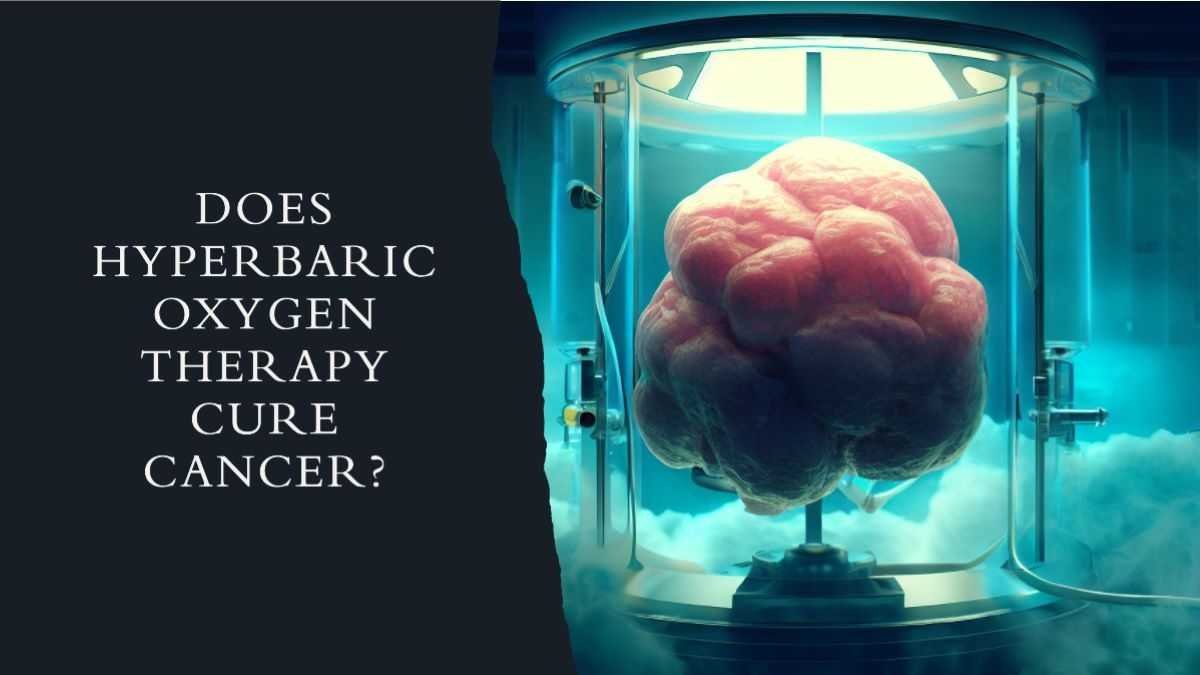Does hyperbaric oxygen therapy cure cancer?

TL;DR: HBOT delivers extra oxygen to tumors, enhancing radiation/chemo effectiveness. It improves outcomes like tumor control and survival for some cancers, especially head/neck, when combined with other treatments. Not a cure itself, but a promising supportive therapy that overcomes tumor hypoxia. More research needed on optimal use.
Hyperbaric Oxygen Therapy (HBOT) has been a subject of numerous studies over the years in relation to its impact on various health conditions including cancer.
In this article we’re going to explore the current state of research and knowledge surrounding Hyperbaric Oxygen Therapy and its potential role in cancer treatment.
*All my claims in this article are backed up by scientific evidence and studies.
Key Takeaways
- HBOT is not a cure but can inhibit tumor growth.
- HBOT enhances radiation/chemo efficacy by increasing oxygen in tumors.
- Improves outcomes for certain cancers like head and neck.
- Reduces risk of cancer recurrence in some cases.
- HBOT has shown potential in treating radiation-induced proctitis in prostate cancer patients.
- Combining HBOT with certain cancer drugs can enhance their effectiveness in treating bone cancer.
- HBOT can improve symptoms and quality of life for cancer patients experiencing late radiation side effects.
- HBOT can slow down the progression of lung cancer by improving oxygen levels in tumors and triggering cancer cell death.
- HBOT can improve symptoms and quality of life for people with late radiation tissue injuries from pelvic cancer treatment.
Understanding Hyperbaric Oxygen Therapy (HBOT)
Before we jump into what the research says, let me tell you – in brief – what HBOT is and how it works.
Hyperbaric Oxygen Therapy (HBOT) is a medical treatment where a patient breathes in pure oxygen in a special pressurized chamber.
The increased pressure and high oxygen levels cause more oxygen to be carried in the blood. This allows more oxygen to reach body tissues, even areas with low oxygen levels.
HBOT has many benefits and it has been used to treat conditions like diving injuries, carbon monoxide poisoning, non-healing wounds, and some infections.
It is thought to help healing and tissue repair by getting more oxygen to the injured areas. The high oxygen levels can also kill certain bacteria and germs.


The Role of Oxygen in Our Bodies & Cancer
Now, that you understood what HBOT is, it is important to understand what oxygen does to our bodies and how it “fights” cancer.
Oxygen is really important for our bodies to work properly. When we breathe, oxygen enters our lungs and then goes into our blood.
In our blood, there are red blood cells that have a protein called hemoglobin. Hemoglobin carries the oxygen and helps transport it to all the different parts of our body through the blood vessels.
Inside our cells, there are tiny structures called mitochondria. The mitochondria use the oxygen to make energy for the cell. This energy is like a battery that powers everything the cell needs to do, like growing, repairing itself, and communicating with other cells.
Oxygen also plays a role in keeping things balanced in our cells. It helps create some molecules called reactive oxygen species (ROS). ROS are important because they help cells “talk to each other” and fight off germs. But if there are too many ROS, they can cause damage. So oxygen helps make ROS, but it also helps get rid of extra ROS to keep everything in balance.
In cancer, low oxygen levels in cells make tumors grow faster. This is called hypoxia. [1]
When cells don’t have enough oxygen, they “switch” to a less efficient way of getting energy, which makes them hungry for glucose. To survive, they create new blood vessels to get more oxygen, but this only helps for a short time.
The lack of oxygen also makes cancer cells resistant to radiation and chemotherapy, especially in cancers like kidney cancer. [2]
Does hyperbaric oxygen therapy cure cancer?
Research shows that HBOT can have positive effects on slowing down cancer cells and can support other cancer therapies, such as aiding tissue recovery after radiation.
Here’s what the scientific literature has to say about Hyperbaric Oxygen Therapy and Cancer or conditions derived from radio therapy or chemo therapy:
- A 2013, peer-reviewed, research article in PLOS ONE found that combining a low-carb, high-fat diet (ketogenic diet or KD) with hyperbaric oxygen therapy (HBO2T) slowed down the growth of cancer in mice with spreading cancer. The KD lowered blood sugar and hindered tumor growth, while HBO2T flooded tumors with oxygen, further stalling cancer growth. Together, these treatments significantly increased survival time in mice with metastatic cancer, suggesting potential as safer cancer therapies.
- A 2006 study published in The Journal of Urology discovered that hyperbaric oxygen therapy helped relieve radiation-induced proctitis in patients treated for prostate cancer. Despite previous treatments failing, all 27 patients completed the oxygen therapy sessions. Many patients experienced improvements, with nearly half seeing bleeding stop and half noticing less urgent bowel movements. Overall, most patients responded well to the therapy, suggesting it as a useful option for managing this challenging condition.
- A 2009 study published in the journal Oncology Reports, found that combining hyperbaric oxygen therapy with a cancer drug called carboplatin shows promise in treating osteosarcoma, a type of bone cancer. The study found that hyperbaric oxygen alone slowed down the growth of osteosarcoma cells in lab tests. When used with carboplatin, it had an even stronger effect. In mice with osteosarcoma, this combination therapy reduced tumor growth and lung spread, suggesting it could be a beneficial treatment approach for patients.
- A 2008 clinical paper published in the International Journal of Oral and Maxillofacial Surgery found out that hyperbaric oxygen therapy (HBOT) might help improve xerostomia and related issues in patients who received radiotherapy for head and neck cancer. 21 patients participated in the study and completed quality of life questionnaires before and after HBOT. Over time, they reported fewer swallowing problems, increased saliva, and improved taste sensation, suggesting HBOT could be beneficial for managing these radiotherapy side effects.
- A study published in the journal Nature discovered that hyperbaric oxygen therapy (HBOT) can slow down the progression of lung cancer by improving oxygen levels in tumors and triggering cancer cell death. Using mice with human lung cancer cells, researchers found that HBOT reduced tumor growth and increased the presence of proteins associated with blood vessel formation. Additionally, HBOT led to more cancer cell death, suggesting it could be a useful addition to lung cancer treatment in the future.
- A 2021 study published in the Breast Cancer Research and Treatment journal concluded that breast cancer patients experiencing late radiation side effects benefited from hyperbaric oxygen therapy (HBOT). After at least 20 HBOT sessions, patients reported less pain and improved symptoms in the breast and arm. Quality of life also improved. The most common side effects were mild, like temporary nearsightedness, with few severe effects. Smoking during HBOT and shorter time since radiation were linked to persistent breast pain.
- In another study, researchers investigated the effects of hyperbaric oxygen (HBO) on ovarian cancer tumors in mice. They found that HBO exposure significantly reduced tumor volume and inhibited the activation of a protein called STAT3, which is associated with tumor growth and drug resistance. Combining HBO with chemotherapy (cisplatin) further reduced tumor volume, but it led to reduced body weight in mice.
- A 2021 article published in Frontiers in Oncology explains how hyperbaric oxygen therapy (HBO) affects non-small-cell lung cancer (NSCLC) cells. NSCLC cells use a process called the Warburg effect to grow, which is controlled by a protein called HIF-1α. HBO reduces HIF-1α levels, slowing down NSCLC cell growth and the Warburg effect. This effect is linked to a specific gene called PFKP. In mice, HBO also slowed down lung tumor growth, suggesting it could be a promising treatment for NSCLC.
- An article published in 2022 in the journal Supportive Care in Cancer found that hyperbaric oxygen therapy (HBOT) improved symptoms and quality of life for people with late radiation tissue injuries (LRTIs) from pelvic cancer treatment. Urinary and bowel symptoms, as well as overall quality of life, improved six months after HBOT. These findings suggest HBOT could be beneficial for cancer survivors with LRTIs.
Cancer Patient Says HBOT Helped Him Heal
According to a CNBC Miami, Bryan Mugione shared how hyperbaric oxygen therapy (HBOT) helped him heal from painful injuries caused by cancer treatments. Mugione expressed feeling rejuvenated with increased energy after completing his HBOT sessions at Broward Health Imperial Point.
Hyperbaric oxygen therapy for cervical cancer
After reviewing 19 papers, it seems that hyperbaric oxygen therapy is generally safe and might help slow down tumor growth in cervical cancer.
These studies suggest that combining it with radiation therapy or using it in younger patients with specific disease stages could improve local tumor control and increase survival rates.
However, there’s some variation in the findings, as one study didn’t show a significant difference in survival for certain stages of cervical carcinoma. Overall, most studies agree (75%) on the therapy’s effectiveness, with some suggesting a possibility (17%) and few disagreeing (8%).
- One of the most important and highly cited studies is a 1978 randomized controlled trial on 320 people with advanced cervical cancer in the UK. They found that using hyperbaric oxygen during radiotherapy improved local control and survival, especially in patients under 55 with stage III disease, despite a slight increase in radiation side effects.
The Verdict: Can HBOT Cure Cancer?
Hyperbaric oxygen therapy does not cure cancer by itself, but it can help in treating some types of cancer when used together with other treatments like radiation and chemo therapies and specific cancer treatment drugs.
The main way HBOT may help is by increasing the oxygen levels in tumors. Many tumors don’t get enough oxygen, which allows the cancer cells to survive better and resist treatments like radiation and chemotherapy.
By providing extra oxygen through HBOT, it can make the tumor cancer cells “weaker” and more susceptible to being killed by radiation or chemotherapy drugs. This “oxygen enhancement” effect makes the other cancer treatments work better, especially for cancers in areas like the head and neck.
Research shows that adding HBOT can improve outcomes like better tumor control, longer survival, and lower chances of the cancer coming back in certain situations. However, HBOT is not free of risks and should only be used when the benefits outweigh the potential downsides.
Overall, while not a cure itself, HBOT seems to be a promising supportive therapy that can boost the effectiveness of standard cancer treatments for some patients by overcoming the issue of low oxygen in tumors. But more studies are still needed to determine the best ways to use this therapy safely and effectively.
For more information on Hyperbaric Oxygen Therapy, check our dedicated HBOT page.
Related
ℹ️ FoodNurish is reader-supported. When you buy through links on our site, we may earn an affiliate commission without any surcharge to you.

